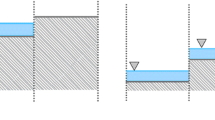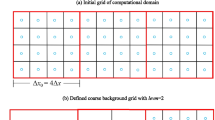Abstract
Flood-induced disasters can cause significant harm and economic losses. Using numerical simulations to provide real-time predictions of flood events is an effective method to address this issue. To develop a high-efficiency and adaptable tool for fast flood prediction in complex terrains, this work utilizes Graphic Processing Units (GPUs) to accelerate a full 2D shallow water model on unstructured meshes. Furthermore, a novel Edge Loop Method (ELM) based on the winged-edge data structure is applied to the model to improve the computational efficiency of solving fluxes. A benchmark test and a real-world dam-break case were simulated to verify the accuracy and performance of the current model. The results demonstrate that the ELM accelerates the model by 2.51 and 4.08 times compared to the eight-core CPU-based model, and 14.97 and 19.84 times compared to the single-core CPU-based model in two cases. Notably, when compared to the GPU-based model using the Cell Loop Method (CLM), the computational efficiency of the ELM is improved by 18.34% and 24.29%, respectively. In particular, a quantitative analysis of the performance explains the advantage of the ELM from the perspective of its implementation mechanism, further demonstrating that the ELM exhibits higher computational efficiency as the total number of cells increases. Based on the advantages of high efficiency in the GPU-based model using the ELM, the proposed model can effectively forecast real-world flood events in regions characterized by complex terrains.













Similar content being viewed by others
Availability of Data and Materials
The data and code that support the study are available from the corresponding author upon reasonable request.
References
Abderrezzak KE, Paquier A, Mignot E (2009) Modelling flash flood propagation in urban areas using a two-dimensional numerical model. Nat Hazards 50(3):433–460. https://doi.org/10.1007/s11069-008-9300-0
Alcrudo F, Mulet J (2007) Description of the Tous Dam break case study (Spain). J Hydraul Res 45:45–57. https://doi.org/10.1080/00221686.2007.9521832
Bellos V, Tsakiris G (2015) 2D Flood modelling: the case of tous dam break. Proceedings of the 36th IAHR World Congress. Hague, Netherlands
Bournas A, Baltas E (2023) Analysis of weather radar datasets through the implementation of a gridded rainfall-runoff model. Environ Process 10(1):7. https://doi.org/10.1007/s40710-023-00621-2
Echeverribar I, M Morales-Hernández, P Brufau, P García-Navarro (2019) 2D numerical simulation of unsteady flows for large scale floods prediction in real time. Adv Water Resour 134. https://doi.org/10.1016/j.advwatres.2019.103444
Environment Agency (2018) Carlisle flood investigation report. https://www.cumbria.gov.uk/eLibrary/Content/Internet/536/6181/42494151257.pdf. Accessed 1 Dec 2023
Frazao S, Testa G (1999) The Toce River test case: numerical results analysis. Proceedings of the 3rd CADAM Workshop. Milan, Italy
Her Y, Yang K, Song J-H (2021) Parallelization of a two-dimensional time-area watershed routing. Environ Model Softw 146:105222. https://doi.org/10.1016/j.envsoft.2021.105222
Hou J, Liang Q, Simons F, Hinkelmann R (2013) A 2D well-balanced shallow flow model for unstructured grids with novel slope source term treatment. Adv Water Resour 52:107–131. https://doi.org/10.1016/j.advwatres.2012.08.003
Hou J, Wang T, Li P, Li Z, Zhang X, Zhao J, Hinkelmann R (2018) An implicit friction source term treatment for overland flow simulation using shallow water flow model. J Hydrol 564:357–366. https://doi.org/10.1016/j.jhydrol.2018.07.027
Hou JM, Zhou N, Chen GZ, Huang MAS, Bai GB (2021) Rapid forecasting of urban flood inundation using multiple machine learning models. Nat Hazards 108(2):2335–2356. https://doi.org/10.1007/s11069-021-04782-x
Hu R, Fang F, Salinas P, Pain CC, Sto ND, Domingo OM (2019) Numerical simulation of floods from multiple sources using an adaptive anisotropic unstructured mesh method. Adv Water Resour 123:173–188. https://doi.org/10.1016/j.advwatres.2018.11.011
Kabir S, Patidar S, Xia X, Liang Q, Neal J, Pender G (2020) A deep convolutional neural network model for rapid prediction of fluvial flood inundation. J Hydrol 590:125481. https://doi.org/10.1016/j.jhydrol.2020.125481
Li D, Hou J, Zhang Y, Guo M, Zhang D (2022) Influence of time step synchronization on urban rainfall-runoff simulation in a hybrid CPU/GPU 1D–2D coupled model. Water Resour Manag 36(10):3417–3433. https://doi.org/10.1007/s11269-022-03158-5
Liang QH (2010) Flood simulation using a well-balanced shallow flow model. J Hydraul Eng 136(9):669–675. https://doi.org/10.1061/(ASCE)HY.1943-7900.0000219
Morales-Hernández M, Hubbard ME, García-Navarro P (2014) A 2D extension of a Large Time Step explicit scheme (CFL>1) for unsteady problems with wet/dry boundaries. J Comput Phys 263:303–327. https://doi.org/10.1016/j.jcp.2014.01.019
Morales-Hernández M, Sharif MB, Kalyanapu A, Ghafoor SK, Dullo TT, Gangrade S, Kao SC, Norman MR, Evans KJ (2021) TRITON: A Multi-GPU open source 2D hydrodynamic flood model. Environ Model Softw 141:105034. https://doi.org/10.1016/j.envsoft.2021.105034
Nash JE, Sutcliffe JV (1970) River flow forecasting through conceptual models part I — A discussion of principles. J Hydrol 10(3):282–290. https://doi.org/10.1016/0022-1694(70)90255-6
Neperud B, Lowther J, Shene CK (2007) Visualizing and animating the winged-edge data structure. Comput Graph-Uk 31(6):877–886. https://doi.org/10.1016/j.cag.2007.08.009
Peng L, Zhang T, Li J, Feng P (2023) Three-dimensional numerical study of dam-break flood impacting problem with VOF method and different turbulence closures. Water Resour Manag 37(10):3875–3895. https://doi.org/10.1007/s11269-023-03530-z
Petaccia G, Leporati F, Torti E (2016) OpenMP and CUDA simulations of Sella Zerbino Dam break on unstructured grids. Comput Geosci 20(5):1123–1132. https://doi.org/10.1007/s10596-016-9580-5
Ritter A, Muñoz-Carpena R (2013) Performance evaluation of hydrological models: Statistical significance for reducing subjectivity in goodness-of-fit assessments. J Hydrol 480:33–45. https://doi.org/10.1016/j.jhydrol.2012.12.004
Toro EF, Spruce M, Speares W (1994) Restoration of the contact surface in the HLL-Riemann solver. Shock Waves 4(1):25–34. https://doi.org/10.1007/BF01414629
Tügel F, Özgen-Xian I, Marafini E, Hadidi A, Hinkelmann R (2020) Flash flood simulations for an Egyptian city - mitigation measures and impact of infiltration. Urban Water J 17(5):396–406. https://doi.org/10.1080/1573062X.2020.1713171
Wang H, Guan X, Meng Y, Wu Z, Wang K, Wang H (2023) Coupling time and non-time series models to simulate the flood depth at urban flooded area. Water Resour Manag 37(3):1275–1295. https://doi.org/10.1007/s11269-023-03430-2
Xia X, Liang Q, Ming X, Hou J (2017) An efficient and stable hydrodynamic model with novel source term discretization schemes for overland flow and flood simulations. Water Resour Res 53(5):3730–3759. https://doi.org/10.1002/2016WR020055
Xia XL, QH Liang, XD Ming (2019) A full-scale fluvial flood modelling framework based on a high-performance integrated hydrodynamic modelling system (HiPIMS). Adv Water Resour 132. https://doi.org/10.1016/j.advwatres.2019.103392
Funding
National Natural Science Foundation of China, No. U21A20164,Jijian Lian,No. U20A20316, Jijian Lian, IWHR Research & Development Support Program, WH0145B022021, Dawei Zhang.
Author information
Authors and Affiliations
Contributions
Conceptualization and Methodology: J. Hou, X. Wang, L. Ma; Writing-original draft preparation: L. Ma; Material preparation, collection and analysis: L. Ma, J. Lian, D. Zhang; Supervision: J. Lian; Funding acquisition: J. Lian, X. Wang. All authors read and approved the final manuscript.
Corresponding author
Ethics declarations
Ethics Approval
Informed consent.
Consent to Participate
Not applicable.
Consent to Publish
The authors are indeed informed and agree to publish.
Competing Interests
None.
Additional information
Publisher's Note
Springer Nature remains neutral with regard to jurisdictional claims in published maps and institutional affiliations.
Rights and permissions
Springer Nature or its licensor (e.g. a society or other partner) holds exclusive rights to this article under a publishing agreement with the author(s) or other rightsholder(s); author self-archiving of the accepted manuscript version of this article is solely governed by the terms of such publishing agreement and applicable law.
About this article
Cite this article
Ma, L., Lian, J., Hou, J. et al. A GPU-Accelerated Full 2D Shallow Water Model Using an Edge Loop Method on Unstructured Meshes: Implementation and Performance Analysis. Water Resour Manage 38, 733–752 (2024). https://doi.org/10.1007/s11269-023-03696-6
Received:
Accepted:
Published:
Issue Date:
DOI: https://doi.org/10.1007/s11269-023-03696-6




